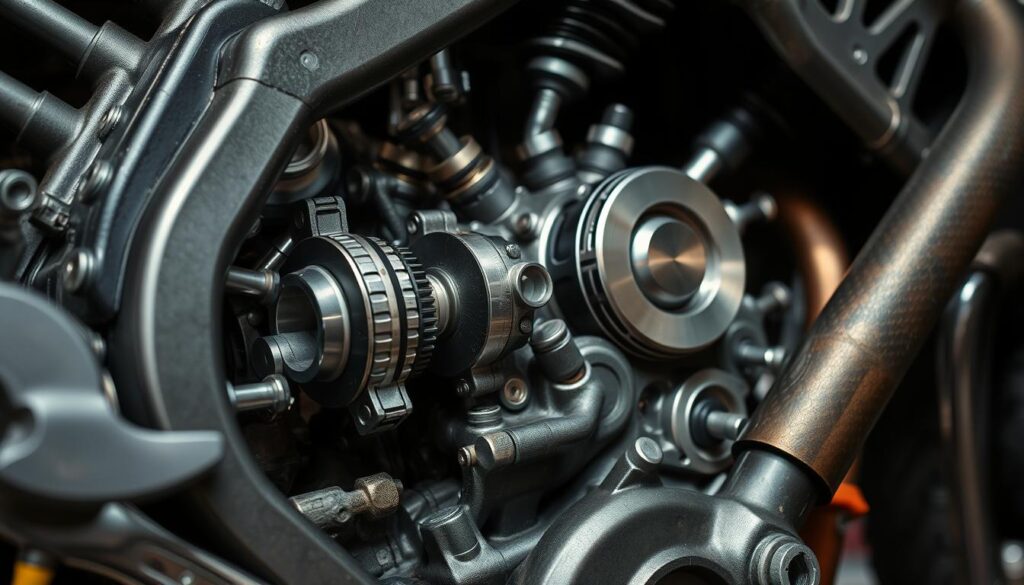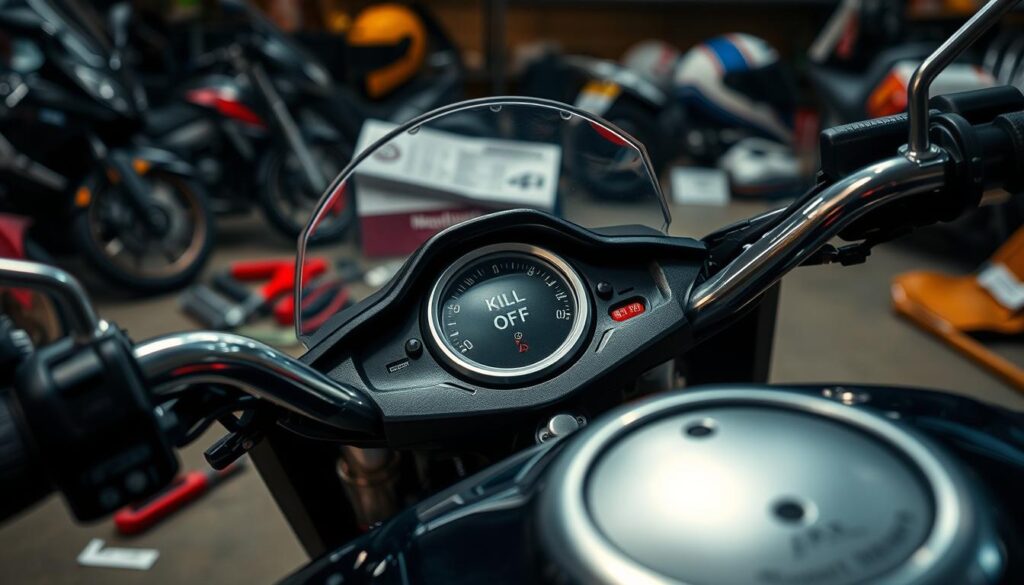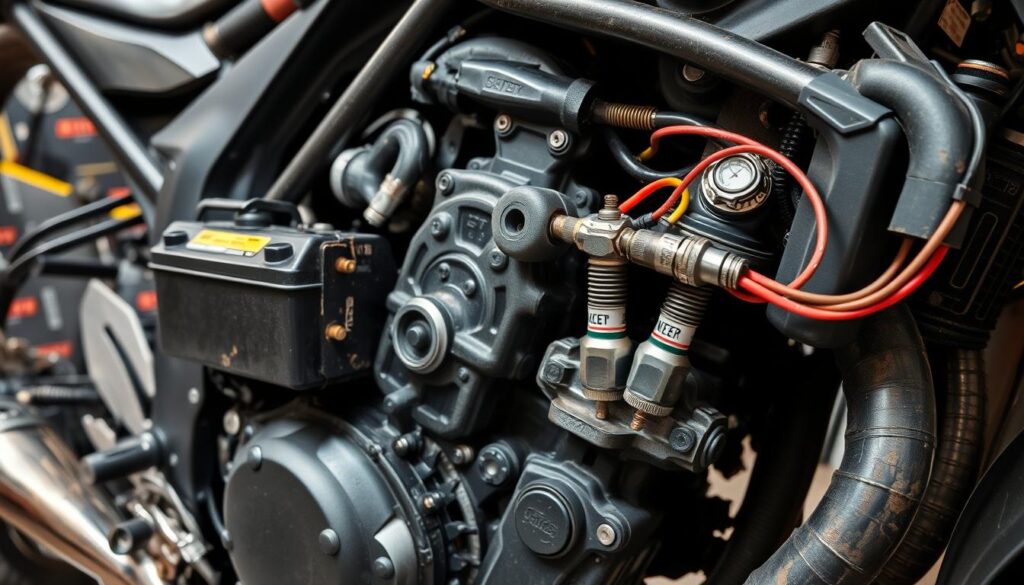There’s nothing like the thrill of hearing your motorcycle roar to life. But what if it just won’t start? Whether you’re a seasoned rider or new to motorcycles, a dead bike can be frustrating. Don’t worry, we’ve got you covered. In this guide, we’ll explore common reasons and how to fix them.
In This Guide
Battery Problems: The Most Common Starting Issue
Many motorcycles won’t start because of battery issues. This can include a dead battery, a weak one, or problems with the electrical connections. Knowing the signs of battery trouble and how to maintain it is crucial for your bike’s health.
Signs of a Dead or Weak Battery
Here are some signs your motorcycle’s battery might be failing:
- Slow or sluggish engine cranking when you turn the key
- Dashboard lights dimming or flickering when the engine is running
- Battery not holding a charge after being parked for a few days
Testing Your Motorcycle Battery
To figure out if your battery is the problem, test it. Use a voltmeter to check the voltage when the engine is off and on. A good battery should show around 12.6 volts when off and 13.8 to 14.7 volts when running.
Battery Maintenance Tips
To keep your battery in good condition and avoid starting issues, follow these tips:
- Clean the battery terminals regularly to ensure a good connection
- Use a smart battery charger to maintain the battery’s charge when the bike is in storage
- Replace the battery every 2-3 years, or as recommended by the manufacturer
By keeping an eye on your motorcycle’s battery health, you can avoid the hassle of a dead battery. This way, your bike will always be ready to go.
Motorcycle Won’t Start: Troubleshooting Basic Issues
If your motorcycle won’t start, finding the problem quickly is key. Start with simple checks to see if they fix the issue. We’ll show you easy steps to get your bike running again.
First, check the battery. A dead or weak battery is a common problem. Look at the battery’s charge and for any damage. If it’s bad, you might need a new one or a charge.
- Check the battery terminals and connections for tightness and corrosion.
- Use a multimeter to test the battery’s voltage. It should be in the range the maker suggests.
- If the battery is low, try jump-starting or charging it with a charger.
Then, look at the fuel system. Make sure the tank isn’t empty and the lines aren’t clogged. The fuel pump and carburetor or fuel injection system should work right.
- Look for kinks, cracks, or blockages in the fuel lines.
- Check and replace the fuel filter if needed.
- Make sure the fuel pump is working and fuel is getting to the engine.
Also, check the ignition system. Spark plugs and ignition coils should be good. Look for any loose or damaged wiring in the ignition circuit.
By fixing these basic problems, you can often solve the issue. If not, you might need to look deeper into the systems. Stay tuned for more on complex problems that can stop a motorcycle from starting.
Fuel System Problems and Solutions
Your motorcycle’s fuel system is key to its performance and reliability. Issues like clogged fuel lines, carburetor problems, and fuel pump failures can stop your bike from starting or running right. Let’s look at these motorcycle fuel system problems and find ways to fix them.
Clogged Fuel Lines and Filters
Dirt, rust, and debris can block your motorcycle’s fuel lines and filters over time. This can make starting hard, cause misfires, and even stop fuel flow. Check and clean your fuel lines often, and swap out any clogged or damaged filters.
Carburetor Issues
Carburetors need the right tuning and care. Problems like stuck floats, clogged jets, or worn diaphragms can mess up the fuel-air mix. This can lead to starting issues and poor engine performance. Fix and rebuild your carburetor as needed for the best motorcycle engine repair.
Fuel Pump Failures
A bad fuel pump can stop fuel from getting to the engine, causing it not to start. Check if you hear the fuel pump’s priming sound when you turn the ignition. Test the pump’s pressure to find problems. Replace a bad fuel pump to get fuel flowing right again.
| Fuel System Issue | Potential Causes | Solutions |
|---|---|---|
| Clogged Fuel Lines and Filters |
|
|
| Carburetor Problems |
|
|
| Fuel Pump Failures |
|
|
By fixing these common motorcycle fuel system problems, your bike will start reliably and run well. Regular care and watching for issues can avoid expensive motorcycle engine repair later.
Ignition System Complications
When your motorcycle won’t start, the ignition system might be the problem. It’s responsible for sparking the air-fuel mix in your engine. Any issues here can stop your bike from starting or running right.
Spark plugs often wear out, leading to weak or no spark. This can happen due to carbon buildup or wrong gap settings. Regularly inspecting and replacing your spark plugs keeps your motorcycle ignition system working well.
Ignition coils also play a key role. They turn the battery’s low voltage into high voltage for the spark plugs. If a coil fails, it can stop the spark plug from getting the needed voltage. This leads to starting problems. Fixing and replacing faulty ignition coils is vital for your motorcycle engine repair.
Timing problems can also affect the ignition system. The spark must be delivered at the right time in the engine’s cycle. If timing is off, you might see misfiring, poor performance, or engine damage. Adjusting the ignition timing correctly is crucial for your motorcycle’s health.
Knowing the common ignition system problems helps you fix them early. Regular maintenance, timely replacements, and adjustments keep your motorcycle ignition system in top shape.
Starter Motor and Starting Circuit Issues
If your motorcycle won’t start, it might be the starter motor or the starting circuit. Fixing these electrical problems is key to getting your bike running again.
Common Starter Motor Problems
The starter motor cranks the engine to start. Issues like worn brushes, a seized motor, or a failed solenoid can stop it from working. This leaves your motorcycle unable to start.
Diagnosing Electrical Connections
Bad electrical connections in the starting circuit can also cause problems. Look at the battery terminals, ignition switch, and wiring for any damage. Use a multimeter to check for issues in these connections.
Relay and Solenoid Troubles
The starting circuit needs a relay and solenoid to work right. If they fail, they can block the electricity flow. Test and replace them if needed to fix the problem.
| Common Starter Motor Problems | Diagnosing Electrical Connections | Relay and Solenoid Troubles |
|---|---|---|
|
|
|
Fixing starter motor, electrical connection, and relay/solenoid problems can solve starting issues. Always be safe and seek a mechanic’s help if unsure about electrical work.
Engine Compression Problems
If your motorcycle won’t start, it might be because of engine compression issues. Low compression stops the engine from firing up right. Finding and fixing these problems is key to getting your bike running again.
Symptoms of Low Engine Compression
- Difficult starting, especially when the engine is cold
- Rough idling or stalling
- Lack of power or poor acceleration
- Misfiring or engine knocking
Testing Engine Compression
To check engine compression, you need a compression gauge. This tool measures pressure in the cylinders. Here’s how to use it:
- Warm up the engine to operating temperature
- Remove the spark plugs
- Connect the compression gauge to the spark plug hole
- Crank the engine and note the reading on the gauge
- Repeat the test for each cylinder
The readings should be between 150-200 psi. If one or more cylinders have low compression, it could mean worn piston rings or leaky valves.
Causes of Low Engine Compression
| Cause | Symptom | Solution |
|---|---|---|
| Worn piston rings | Uneven compression across cylinders | Replace piston rings |
| Leaky valves | Low compression in one or more cylinders | Adjust or replace valves |
| Damaged cylinder head | Low compression across all cylinders | Repair or replace cylinder head |
Fixing engine compression problems can be a big job. It might mean rebuilding the engine or replacing major parts. It’s crucial to find the problem right and fix it to get your motorcycle running well again.

Weather-Related Starting Issues
Motorcyclists face challenges when the weather changes. Cold or hot temperatures can affect your bike’s start-up. Knowing how to start your motorcycle in extreme weather is key for a smooth ride.
Cold Weather Starting Tips
Cold weather makes starting your motorcycle harder. It can harm your battery, fuel system, and engine. To start your bike easily in cold, follow these tips:
- Make sure your battery is strong and fully charged. A weak battery can struggle in cold.
- Use a fuel additive to prevent gelling or waxing in the fuel lines and carburetor.
- Let your engine warm up for a few minutes before riding. This helps the oil and engine reach the right temperature.
- Think about using a motorcycle battery warmer or engine block heater to pre-heat before starting.
Hot Weather Starting Problems
High temperatures also cause starting issues. Heat can make fuel vaporize faster, leading to fuel system problems. It can also stress your battery and electrical parts. To solve hot weather starting problems, try these:
- Check your fuel system for clogs or blockages that heat can worsen.
- Ensure your battery is strong and fully charged. Heat can quickly drain a battery’s power.
- Consider a high-performance battery or a battery maintenance system to keep it cool and reliable.
- Park your motorcycle in the shade to reduce sunlight’s impact on the engine and fuel system.
Understanding cold and hot weather starting challenges helps keep your motorcycle running smoothly. This way, you can enjoy riding, no matter the weather.
Safety Switch and Kill Switch Malfunctions
If your motorcycle won’t start, it might be the safety or kill switch’s fault. These parts are key to starting your bike. Knowing how to fix them is important for getting your motorcycle running again.
The Role of Safety and Kill Switches
Safety switches turn off the ignition if your bike isn’t ready, like if the kickstand is down. Kill switches let you stop the engine quickly in an emergency.
If these switches don’t work right, your bike won’t start. Finding and fixing these problems is essential to get your motorcycle moving again.
Troubleshooting Safety and Kill Switch Problems
To fix safety and kill switch issues, follow these steps:
- Check the switches for damage or wear
- Use a multimeter to test the switches for continuity
- Look at the wiring and connections for any issues
- Replace faulty switches or electrical parts
By fixing your motorcycle’s safety and kill switches, you can start your bike and ride with confidence.

Regular maintenance and quick troubleshooting help avoid and fix motorcycle starting problems. Stay alert and fix issues fast to keep your bike running well and enjoy the ride.
Conclusion
Your motorcycle might not start for many reasons. These include battery issues, fuel system problems, and ignition system troubles. Keeping up with regular maintenance is key. It helps your bike start reliably every time.
It’s important to look after your motorcycle’s battery, fuel system, and ignition. Regular check-ups and quick fixes can prevent starting problems. This way, you can avoid the hassle of a bike that won’t start.
Whether you’re a seasoned rider or new to motorcycles, knowing about starting issues helps. Following good maintenance practices keeps your bike running well. With the right care, you’ll enjoy many worry-free rides ahead.

